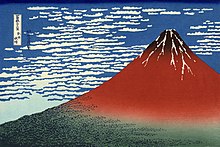The red tree

|
| The red tree |
|---|
| Marianne von Werefkin , 1910 |
| Tempera on cardboard |
| 75.5 × 56.5 cm |
| Fondazione Marianne Werefkin , Museo comunale d'arte, Ascona |
The red tree is the title of a painting that the Russian artist Marianne von Werefkin painted in Munich in 1910. The work belongs to the holdings of the Fondazione Marianne Werefkin (FMW) in Ascona . It has the inventory number FMW-0-0-17. A previously colored gouache exists in the FMW in the sketchbook No.:a/21.
Technology, dimensions and labeling
It is a tempera painting on cardboard , 75.5 × 56.5 cm. There are no labels.
iconography
The painting “The Red Tree” is a seemingly hierarchical picture. There is something “cult” about it from Russian prehistoric times. Essentially, this picture consists of only a few striking motifs. The central axis is dominated by a steep cone hill and a tree, under which a person crouches who looks to the right at a chapel . Behind this is a yellow bush. The three basic colors dominate the scenery. The yellow, the brightest of these colors, plays the smallest role in quantitative terms. Shown in moving lines and vortices, it signals the ability to expand aggressively and uncontrollably. The red, on the other hand, the epitome of all cosmic and inner human life forces, is contained in a three-part, blooming tree crown. The tree can be understood as the tree of life . The mighty mountain with a snow-covered double peak towers over the center of the picture and summarizes all the details of the depiction. The painter covered it with rivers of blue that seem to flow down from an icy height.
From wide format to portrait format

Werefkin shows the scenery of the painting in a portrait format, which is unusual for the genre of landscape painting, and suggests an interpretation of the content as symbolic for invisible worlds of the soul and the spiritual. The representative painting was developed from a 12.5 × 18 cm gouache in a wide format that corresponds to the landscape theme. All the picture elements and colors mentioned are already given in the sketch. The red tree, the person crouching in front of it, the chapel and the yellow bush appear, however, pushed to the right edge of the picture. However, two mountains, separated by a deep gorge, occupy the background. It was only in the painting that they were merged into a single mountain, the summit of which has assumed the appearance of an atavism , the appearance of a crater , of a formerly active volcano . It is reminiscent of the Japanese Fuji (volcano) . The fact that “The Red Tree” could have something to do with Japanese art with Hokusai's woodcut “Pine in front of Fuji” is hardly noticeable at first glance. However , the relationship becomes immediately apparent when compared with Jawlensky's “Pine in Orange” . It is easy to see that in those years Werefkin had transformed Japanese art to a degree that Jawlensky was not yet able to do.
literature
- Clemens Weiler : Marianne von Werefkin. Exhib. Cat .: Marianne Werefkin 1860–1938. Städtisches Museum Wiesbaden 1958, undated, cat.no.43, b / w-fig. (P. 25)
- Bernd Fäthke : Marianne Werefkin and her influence on the Blue Rider. In: exhib. Cat .: Marianne Werefkin, paintings and sketches. Museum Wiesbaden 1980, p. 97, b / w-fig. 48
- Bernd Fäthke: Marianne Werefkin. Munich 2001, ISBN 3-7774-9040-7 , color. Fig. No. 170, p. 147
- Bernd Fäthke: Marianne Werefkin: Clemens Weiler's Legacy. In: Tanja Malycheva, Isabel Wünsche (Ed.): Marianne Werefkin and the Women Artists in her Circle. Leiden / Boston 2016, ISBN 978-9-0043-2897-6 , pp. 8-19, pp. 8-19, here pp. 14-19; JSTOR 10.1163 / j.ctt1w8h0q1.7
Individual evidence
- ↑ Orlando Figes: Natascha's dance, A cultural history of Russia. Berlin 2003, p. 150 ff.
- ↑ Collection of the Fondazione Marianne Werefkin in Ascona, inventory number FMW 46-6-649-a21 / 33.
- ↑ Bernd Fäthke: Marianne Werefkin. Munich 2001, p. 146, color illus. # 168.
- ^ Maria Jawlensky, Lucia Pieroni-Jawlensky, Angelica Jawlensky (eds.): Alexej von Jawlensky, Catalog Raisonné of the oil-paintings. Vol. 1, Munich 1991, No. 351, p. 287 with b / w illus.
- ↑ Bernd Fäthke: Von Werefkins and Jawlensky's weakness for Japanese art. In: exhib. Cat .: "... the tender, spirited fantasies ...", the painters of the "Blue Rider" and Japan. Murnau Castle Museum 2011, p. 120 f, color illus. 36-39.